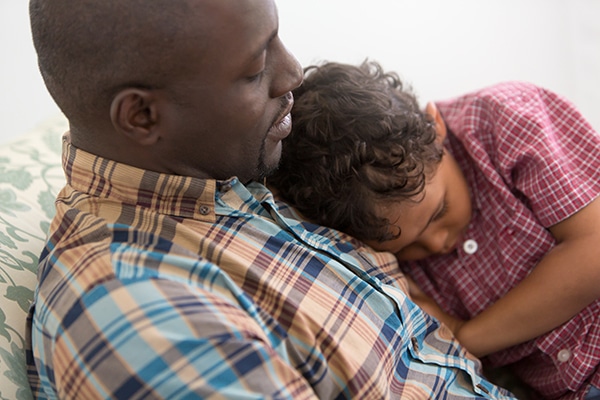

Anxiety is a physically and emotionally uncomfortable experience that generally makes someone want to escape the anxiety-provoking situation as quickly as possible. Anxiety is the most common behavioral health complaint across development. A little bit of anxiety can actually help people stay alert and focused and can also help children behave in a safe way. For example, a fear of fire would lead to an avoidance of playing with matches or a fear of failing a test may motivate a teen to study. However, if anxiety persists and interferes with typical child/teen functioning, it may warrant professional attention.
Some signs that a child/teen may be anxious include:
- Becoming clingy, easily distracted, or avoidant of certain activities/situations
- Problems getting to sleep and/or staying asleep
- Sweaty hands, accelerated heart rate and breathing
- Headaches, stomachaches, nausea
The nature of anxieties and fears change as kids grow and develop
- Babies from 6-8 months and again around 12 to 18 months old experience separation anxiety.
- Toddlers ages 2-3 may express fears of loud noises, fire, water, darkness, nightmares, or animals
- Kids ages 4-6 tend to have anxiety about things that aren’t based in reality, such as fears of monsters and ghosts.
- Kids ages 7-12 often have fears that reflect real circumstances that may happen to them. They include fear of bodily injury/harm, natural disasters, strangers, heights, darkness, animals, blood, insects, and being left alone. Kids may learn to fear something after having an unpleasant experience.
- Adolescents may experience anxiety related to social acceptance and academic achievement.
Supportive adults can use specific strategies to help kids develop skills to overcome their anxiety/fears
Anxiety is real and naming it can help. Even if your child’s fear seems insignificant, it may feel very distressing to him/her. Acknowledging and naming the fear for what it is and letting your child know that it’s okay to be frightened can help. Minimizing or shrugging off a fear will likely not help it go away.
Teach children to identify and rate anxiety. Once you let your child know that feeling anxious is okay, you can teach him/her to notice and communicate about anxiety. Have your child list fearful situations and describe how his/her body feels when anxious. A child/teen can also learn to rate fear on a 1-10 scale, describe it as a “small, medium, or big,” or draw a picture of how “full” his/her body feels of fear (i.e., to the knees, stomach, or head).
Teach children simple coping strategies. When your child can identify a fear, they can then do something about it to feel better. Teach them to take slow, deep breaths to relax, think a reassuring thought (e.g., “I can do it!”), or ask for help from a trusted adult. Role playing in advance how to handle a fearful situation can help too. Some children benefit from keeping a security item with them to help them feel brave as well.
Don’t give in to anxiety-driven avoidance. Anxiety tells us to avoid whatever is making us feel uncomfortable. But, if we stay away from something we fear over time, anxiety gets worse instead of better. For example, if your child is fearful of dogs, don’t cross the street deliberately to avoid a dog. This will send the message that dogs are a danger or a threat, which leads to an increase in anxiety. Instead, gently approach a fearful situation with extra support and coping skills in place. Your child needs to know that anxiety is temporary and something he/she can cope with.
Practice good prevention strategies. Keeping consistent routines and expectations for your child can go a long way to preventing episodes of problematic anxiety/worry. Additionally, all children benefit from 10-11 hours of sleep/night (9 hours/night for teens), a nutritious diet, and daily physical activity. These lifestyle management techniques are essential to healthy emotional and behavioral functioning.
Reference: (adapted from) http://kidshealth.org
When and how to seek professional support
Persistent, distressing anxiety that is interfering with functioning (i.e., resulting in withdrawal from typical activities, problems with relationships, sleep/concentration disturbance, or worse school performance) should be evaluated by a qualified mental health professional. Evidence-based treatment for anxiety disorders may include cognitive-behavioral therapy and medication management. Resources to find a local mental health professional or therapist include: your child’s pediatrician, your child’s school counselor, your insurance provider, the Kentucky Psychological Association, or PsychologyToday.com.
Additional resources for kids/parents
“What to do when you worry too much: A kids guide to overcoming anxiety” by Dawn Huebner, Ph.D.
“Helping your anxious child: A step-by-step guide for parents” by Ronald Rapee, Ph.D.
Additional resources for teens/parents
“My anxious mind: A teen’s guide to managing anxiety and panic” by Michael A. Tompkins, Katherine A. Martinez, and Michael Sloan
“If your adolescent has an anxiety disorder: An essential resource for parents” by Edna Foa
Helpful website
Relaxation apps (free versions on Itunes and Android) —
Breathe2Relax
Stop, Breathe, and Think
Headspace
Mindfulness for Children
Smiling Mind









